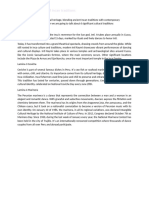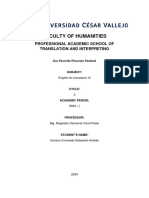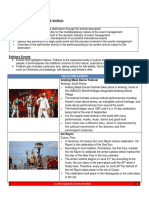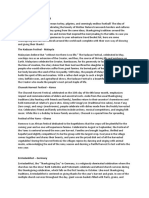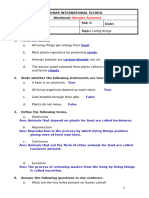Inti Raymi
Inti Raymi
Uploaded by
dayrondanilohuamanenriquezCopyright:
Available Formats
Inti Raymi
Inti Raymi
Uploaded by
dayrondanilohuamanenriquezCopyright
Available Formats
Share this document
Did you find this document useful?
Is this content inappropriate?
Copyright:
Available Formats
Inti Raymi
Inti Raymi
Uploaded by
dayrondanilohuamanenriquezCopyright:
Available Formats
Inti Raymi: The Festival of the Sun
History
Inti Raymi, meaning "Festival of the Sun" in Quechua, dates back to the era of the Inca Empire. Initiated
by the Inca Pachacutec around 1430, it was a vital religious ceremony honoring Inti, the sun god.
Celebrated during the winter solstice on June 21st, it marked the shortest day of the year and
symbolized the sun's return to its prominent position in the sky. Following the Spanish conquest, the
festival was banned but was revived in 1944 thanks to the efforts of Peruvian writer Francisco Espinoza
Navarro. Today, it remains a significant cultural event in Cusco, Peru.
Traditional Food
During Inti Raymi, traditional Inca foods and beverages, such as chicha (a fermented corn drink), are
consumed. The feast includes a variety of dishes made from corn, potatoes, and other native
ingredients, reflecting the agricultural bounty of the Andean region. This ritual consumption of food
connects participants with their ancestral roots and the earth's fertility.
Clothes
Participants in Inti Raymi wear elaborate costumes that replicate traditional Inca attire. These include
brightly colored garments adorned with gold and silver ornaments, symbolizing the sun. The Sapa Inca,
or emperor, wears the most elaborate costume, complete with a sun mask and a feathered headdress.
These costumes are carefully crafted to honor the Inca heritage and are an integral part of the festival's
pageantry.
Parades
The festival features a grand procession that begins at the Qorikancha (Temple of the Sun) in Cusco. The
Sapa Inca, carried on a golden throne, leads the parade, followed by nobles and priests. The procession
moves through the main square, Plaza de Armas, and culminates at the fortress of Sacsayhuaman. Here,
ceremonial activities, including dances, speeches, and rituals, take place. The procession and subsequent
ceremonies are a vivid reenactment of ancient Inca traditional.
Live Music
Music is a crucial element of Inti Raymi, with traditional Andean instruments such as pan flutes, drums,
and charangos (small string instruments) being played. The music accompanies dances and rituals
throughout the festival, enhancing the celebratory atmosphere. Songs in Quechua, the language of the
Incas, are performed, reinforcing cultural identity and continuity. This musical heritage is a testament to
the enduring legacy of the Inca Civilization.
Inti Raymi not only serves as a vibrant reminder of the Inca Empire's grandeur but also as a living
tradition that connects modern Peruvians with their rich cultural heritage. It is a spectacular blend of
history, culture, and communal pride, making it one of the most important and visually stunning
festivals in South America.
You might also like
- 26 Ecological Pyramids-S RennelDocument8 pages26 Ecological Pyramids-S Rennelapi-32383118283% (18)
- Fiverr Test English 2020Document77 pagesFiverr Test English 2020The Girls Academy0% (1)
- Evidence Take A BreakDocument7 pagesEvidence Take A BreakNataly DiazNo ratings yet
- Description of A Festival EssayDocument2 pagesDescription of A Festival EssayMateo IbarraNo ratings yet
- Fact File Example - Inti RaymiDocument1 pageFact File Example - Inti RaymiElena Florit GomilaNo ratings yet
- The Inti Raymi FestivalDocument6 pagesThe Inti Raymi FestivalLuisa YañezNo ratings yet
- Presdentation 1Document1 pagePresdentation 1MILAGROS LIZA ESPINOZANo ratings yet
- Inti Raymi, PeruDocument3 pagesInti Raymi, PeruLiliana Miroslava Ruiz VelascoNo ratings yet
- 5 Reasons Not To Miss Inti RaymiDocument2 pages5 Reasons Not To Miss Inti RaymiDiego CabreraNo ratings yet
- Incas Character 2fcontextDocument17 pagesIncas Character 2fcontextapi-431451571No ratings yet
- Inti Raymi en CuscoDocument1 pageInti Raymi en CuscoLILIANA MAMANI MOROCCONo ratings yet
- Faculty of HumanitiesDocument5 pagesFaculty of HumanitiessebaaaasssssssNo ratings yet
- Sun and Moon Party: Administraci ÓN Y NegociosDocument4 pagesSun and Moon Party: Administraci ÓN Y NegociosRotBlauNo ratings yet
- Festivity of The CandelariaDocument7 pagesFestivity of The CandelariajhonNo ratings yet
- Inti RaymiDocument1 pageInti RaymiIgnacia LuisaNo ratings yet
- InglesDocument17 pagesInglesKusa KausayNo ratings yet
- The Festivity of The Lord of LurenDocument1 pageThe Festivity of The Lord of LurenNancy Huachua RamirezNo ratings yet
- Inti RaymiDocument4 pagesInti RaymiCesar TesilloNo ratings yet
- Unit-4 Folklore EventsDocument10 pagesUnit-4 Folklore EventsKatrina JavierNo ratings yet
- Carnival in OruroDocument12 pagesCarnival in OruroJuank RamirezNo ratings yet
- Inti RaymiDocument1 pageInti RaymiHeydy Lucero PurihuamanNo ratings yet
- Ecuador - InglesDocument12 pagesEcuador - InglesZulema Soto VelasquezNo ratings yet
- Inti RaymiDocument2 pagesInti RaymiSoleil ValleNo ratings yet
- Peruvian CultureDocument7 pagesPeruvian CulturejemuelNo ratings yet
- The Cajamarquino Carnival Is One of The Most Important and Colorful Festivities in The City of CajamarcaDocument1 pageThe Cajamarquino Carnival Is One of The Most Important and Colorful Festivities in The City of CajamarcaRoberth Gil DiazNo ratings yet
- Entregable 1 InglesDocument31 pagesEntregable 1 InglesJack FloresNo ratings yet
- Inti Raymi Ecuador Celebrations - Inca Festival of The Sun GodDocument1 pageInti Raymi Ecuador Celebrations - Inca Festival of The Sun GodGuiselle ManchenoNo ratings yet
- Philippine Festivals-Music&ArtsDocument9 pagesPhilippine Festivals-Music&ArtsCherry BrutasNo ratings yet
- Inca - Richmond County School SystemDocument13 pagesInca - Richmond County School SystemBányácski EmíliaNo ratings yet
- Unidad Educativa Franciscana San Antonio: Unit 1 Project 1 Activity 1Document5 pagesUnidad Educativa Franciscana San Antonio: Unit 1 Project 1 Activity 1Juan GarciaNo ratings yet
- Customs and Traditions of IcaDocument25 pagesCustoms and Traditions of IcaScribdTranslationsNo ratings yet
- Philippinefestivals 151016050956 Lva1 App6891Document75 pagesPhilippinefestivals 151016050956 Lva1 App6891pastorpantemgNo ratings yet
- CulturDocument6 pagesCulturINFANTESARNo ratings yet
- Costumbres y Fiestas Costumbristas.: VendimiaDocument34 pagesCostumbres y Fiestas Costumbristas.: VendimiaLucianoNerudaNo ratings yet
- Festivals and Important Celebrations Around The WorldDocument3 pagesFestivals and Important Celebrations Around The WorldSamYchaNo ratings yet
- Inca Music in Oxford Music OnlineDocument8 pagesInca Music in Oxford Music OnlineLucas de FreitasNo ratings yet
- Descriptive GuelaguetzaDocument2 pagesDescriptive GuelaguetzaMiguel Angel RafaelNo ratings yet
- Apung Iru FestivalDocument2 pagesApung Iru FestivalShayneNo ratings yet
- Romero, Raúl. Peru. Andean Music of Life, Work, and Celebration. (2013)Document44 pagesRomero, Raúl. Peru. Andean Music of Life, Work, and Celebration. (2013)CelestinoPQNo ratings yet
- Discover The Magic of PeruDocument2 pagesDiscover The Magic of PeruSofia CamilaNo ratings yet
- Arts7WS - Q4 - Week 1Document18 pagesArts7WS - Q4 - Week 1Ned Joana DinglasanNo ratings yet
- Incan CivilizationDocument14 pagesIncan CivilizationKinaNo ratings yet
- Traditions of CajamarcaDocument10 pagesTraditions of CajamarcaScribdTranslationsNo ratings yet
- Ati Atihan FestivalDocument13 pagesAti Atihan FestivalGindayl SombilonNo ratings yet
- The CarnivalDocument3 pagesThe CarnivalAnonymous lzMDD42No ratings yet
- Inti RaymiDocument1 pageInti RaymiCynthia Gomez CerronNo ratings yet
- Culture Perú: Gastronomy: The Most Representative Dishes of This CountryDocument2 pagesCulture Perú: Gastronomy: The Most Representative Dishes of This CountryKaren Julieth DIAZ MORALESNo ratings yet
- Cueva Zúñiga, Alvaro Fernando The National Cherry Blossom FestivalDocument1 pageCueva Zúñiga, Alvaro Fernando The National Cherry Blossom FestivalAlvaro Cueva ZuñigaNo ratings yet
- Ati Atihan FestivalDocument3 pagesAti Atihan FestivalJaime Jr CuragNo ratings yet
- Research On FestivalDocument12 pagesResearch On FestivalNiño Prince B. VillarinNo ratings yet
- Q4 Music Lecture 24 WK 1 2Document6 pagesQ4 Music Lecture 24 WK 1 2dianne sulaNo ratings yet
- CuscoDocument9 pagesCuscoJulio Fiestas RomeroNo ratings yet
- Thanksgiving Traditions Around The WorldDocument28 pagesThanksgiving Traditions Around The WorldMarina PeshovskaNo ratings yet
- Ica FestividadesDocument4 pagesIca Festividadesjavier valdiviaNo ratings yet
- Evolution of Music in PeruDocument22 pagesEvolution of Music in PeruScribdTranslationsNo ratings yet
- Various Contemporary Arts of The PhilippinesDocument25 pagesVarious Contemporary Arts of The PhilippinesAmelito GonzalesNo ratings yet
- FestivalsDocument6 pagesFestivalsdafdaf_mendoza9242No ratings yet
- DiadelosMuertos History and Customs EnglishDocument12 pagesDiadelosMuertos History and Customs EnglishAguirre Rodríguez Jade AsenetNo ratings yet
- Festivals in The PhilDocument5 pagesFestivals in The PhilecaNo ratings yet
- Brief History of DanceDocument2 pagesBrief History of DanceKent GallardoNo ratings yet
- Read ArticleDocument1 pageRead ArticleIsolina Huaco CoronadoNo ratings yet
- Q1 Lesson-1Document20 pagesQ1 Lesson-1Alyah Jannah HiñolaNo ratings yet
- Burger King Hiring Process - Job Application, Interview, and Employment - Job Description and Resume ExamplesDocument9 pagesBurger King Hiring Process - Job Application, Interview, and Employment - Job Description and Resume ExamplesZeina ZwayhedNo ratings yet
- Outlook For The Global Egg Industry 2022 - Nan Dirk Mulder - FinalDocument30 pagesOutlook For The Global Egg Industry 2022 - Nan Dirk Mulder - FinalMatheus SouzaNo ratings yet
- Create A Dashboard in ExcelDocument36 pagesCreate A Dashboard in Excelmilou88No ratings yet
- P K Dhara PDFDocument5 pagesP K Dhara PDFArnab PaulNo ratings yet
- Grade 4 LAS Q3 W4 EngDocument3 pagesGrade 4 LAS Q3 W4 EngManny Robledo AlanoNo ratings yet
- A Report On KFCDocument27 pagesA Report On KFCTabaraAnannya100% (1)
- UNIT 6 - Party Time! PDFDocument11 pagesUNIT 6 - Party Time! PDFJuan C. FlorezNo ratings yet
- ĐỀ MINH HỌA THI HKII - KHỐI 10Document14 pagesĐỀ MINH HỌA THI HKII - KHỐI 10Duy BảoNo ratings yet
- VEDA SAMSKRUTI SAMITI-Invite - Vedic Sciences - 251021Document6 pagesVEDA SAMSKRUTI SAMITI-Invite - Vedic Sciences - 251021phdpushNo ratings yet
- Paraceli S: The of TheDocument2 pagesParaceli S: The of TheLaarnie LinggayoNo ratings yet
- 1720020844438.AS - WB - CB - III - EVS - Living ThingsDocument5 pages1720020844438.AS - WB - CB - III - EVS - Living Thingspriti90meshramNo ratings yet
- 2EP. It's My BirthdayDocument8 pages2EP. It's My BirthdaymarinavsanzNo ratings yet
- Đe Tham Khao Anh 7 2024Document8 pagesĐe Tham Khao Anh 7 2024Cao Hoang VuNo ratings yet
- Major Tribes of North EastDocument40 pagesMajor Tribes of North EastFardil DilshadNo ratings yet
- Dadp Ernakulam PDFDocument46 pagesDadp Ernakulam PDFShihab AliNo ratings yet
- Unit 1-2-3Document3 pagesUnit 1-2-3Carlie 789No ratings yet
- Nutrition Plan For PCOS PCODDocument3 pagesNutrition Plan For PCOS PCODshikta sanyalNo ratings yet
- 15 Topic Speaking B1 Epu 1 1 1Document7 pages15 Topic Speaking B1 Epu 1 1 1DuNo ratings yet
- Handouts - Utsa Sports NutritionDocument3 pagesHandouts - Utsa Sports Nutritionapi-735758255No ratings yet
- Unethical Behavior of Tesco PLCDocument5 pagesUnethical Behavior of Tesco PLCNicole AgustinNo ratings yet
- 1.in Turbulent Seas SummaryDocument55 pages1.in Turbulent Seas SummaryKarl Arne AmianaNo ratings yet
- Food Fortification Strategic Plan Final Press Signed - Aug 2018Document75 pagesFood Fortification Strategic Plan Final Press Signed - Aug 2018Abdul OmarNo ratings yet
- Chatime: Name: Kawish.K.Hassani Enrolment No. - 20180201040 BBA Sem-5, Sec-1Document4 pagesChatime: Name: Kawish.K.Hassani Enrolment No. - 20180201040 BBA Sem-5, Sec-1Kawish HassaniNo ratings yet
- Ab 21 0460Document8 pagesAb 21 0460faza baihaqiNo ratings yet
- Brosur TourDocument9 pagesBrosur TourBudi MulyonoNo ratings yet
- S 2 FN June Assessment 1Document4 pagesS 2 FN June Assessment 1Trecy NabuNo ratings yet
- Business B CDocument20 pagesBusiness B CRacecertificationvijNo ratings yet






